The Critical Foundation Beneath Your Roof
Roof decking replacement is the process of installing new structural sheathing (plywood or OSB) that forms the foundation of your roofing system. This critical layer supports your shingles and underlayment, protecting your home from the elements. A compromised deck makes your entire residential roofing system vulnerable to leaks, wind damage, and structural failure.
Quick Answer for Roof Decking Replacement:
- Cost: $5-$8 per square foot ($2,500-$10,000 total project)
- Materials: OSB ($0.30-$1.80/sq ft) or Plywood ($0.50-$2.00/sq ft)
- Timeline: 1-3 days, depending on roof size and complexity
- When Needed: Sagging, water damage, rot, or when over 30% of the deck is deteriorated
- Professional Required: Yes, for safety, code compliance, and warranty protection
Maryland homeowners often find decking issues during inspections or after storms. Key signs include sagging rooflines, ceiling water stains, and spongy spots on the roof. Industry standards recommend a full replacement when 30% or more of the decking shows deterioration. The process involves a full tear-off of old materials, replacing damaged sheathing to meet current building codes, and rebuilding the roof system. For expert guidance on protecting your home, visit our homepage to explore our comprehensive solutions.
With nearly 50 years of experience and over 25,000 projects completed, Whiting Co. Roofing & Exteriors ensures every roof decking replacement meets the highest standards for durability and weather protection in Maryland.
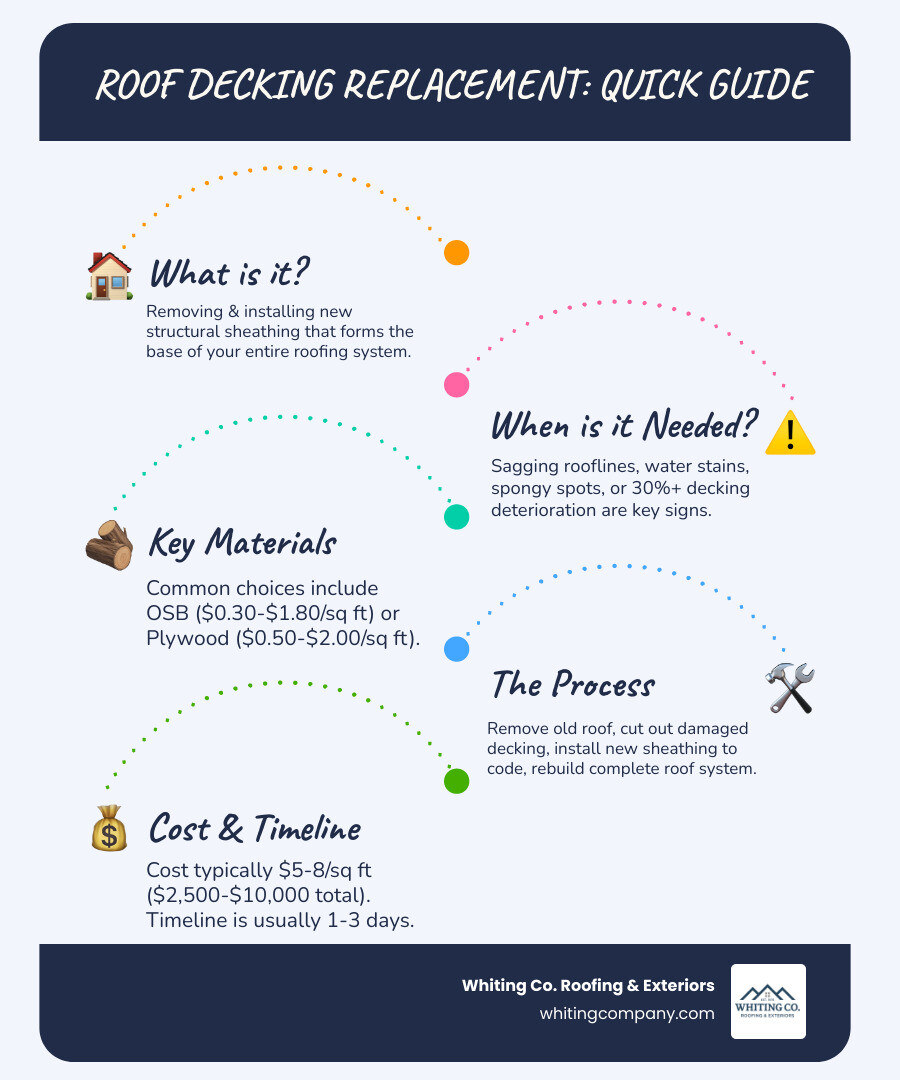
7 Warning Signs Your Roof Decking Needs Replacement
Your roof decking is the structural foundation hidden beneath your shingles. When this critical layer fails, it sends clear distress signals. Recognizing these signs is crucial for protecting your home from significant damage.
- Sagging or Uneven Rooflines: A straight, uniform roofline is a sign of health. Any dips, waves, or sags indicate the decking has lost structural strength, usually due to water damage.
- Water Stains on Ceilings or Walls: Brown or yellow stains on interior surfaces mean moisture has already penetrated your home. The leak has likely soaked the decking, causing rot and weakness.
- Spongy or Soft Spots: When walked on, a healthy roof feels solid. Bouncy or soft sections are a clear sign that moisture has compromised the wood sheathing.
- Visible Cracks or Holes: From your attic, any daylight shining through the underside of the roof represents a direct breach in your home’s protection, allowing entry for water and pests.
- Mold, Mildew, or Rot: Dark patches, fuzzy growth, or a musty smell in your attic are unmistakable evidence of persistent moisture problems that threaten your home’s structure and air quality.
- Telegraphing: This occurs when warped or buckled decking creates visible peaks and valleys that show through the shingles, compromising your roof’s appearance and performance.
- Increased Energy Bills: Damaged decking can compromise insulation and ventilation, allowing conditioned air to escape and forcing your HVAC system to work harder.
Ignoring these signs can lead to structural instability. Industry standards recommend a full replacement if over 30% of the decking is compromised. Schedule a professional roof inspection if you notice any of these symptoms.
Repair or Replace? Making the Right Call
The decision depends on the extent of the damage. Isolated damage from a minor leak may only require a targeted repair. However, widespread rot, sagging, or decking with excessive nail holes (the “swiss cheese” effect from multiple previous reroofs) necessitates a full replacement. Installing a new roof over compromised decking can void manufacturer warranties and violate building codes.
The Risks of Ignoring Damaged Decking
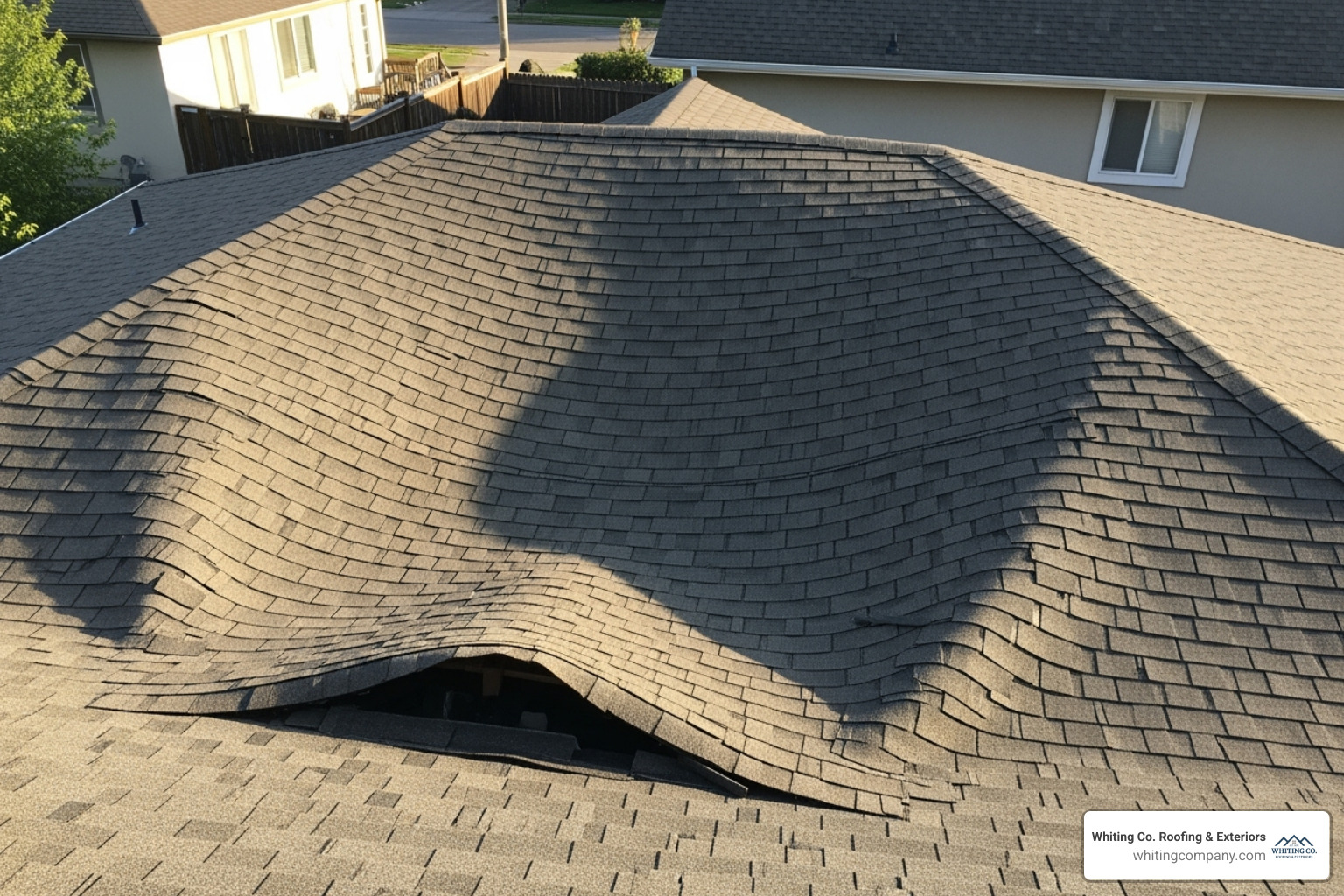
Neglecting decking problems creates a cascade of issues:
- Structural Failure: Weakened decking cannot support roofing materials, snow loads, or wind forces, risking a catastrophic collapse.
- Extensive Water Damage: Water can ruin insulation, damage interiors, and promote widespread mold growth.
- Reduced Property Value: Home inspections will flag compromised decking, complicating or preventing a sale.
- Safety Hazards: Soft spots create fall risks during maintenance, and a compromised roof is more likely to fail during a storm.
In most cases of significant decking damage, a full roof replacement is the only way to restore your home’s safety and value.
The Professional Roof Decking Replacement Process: Step-by-Step Excellence
Roof decking replacement is a complex job that requires professional expertise, safety equipment, and knowledge of building codes. Attempting it as a DIY project can lead to costly mistakes and safety hazards. Our certified team follows a methodical, industry-standard process to ensure your new deck provides a rock-solid foundation.
Step 1: Removing Old Roofing Materials
The process begins with a complete tear-off. Our crew systematically removes all existing shingles, underlayment, and flashing to fully expose the current decking. We protect your property with tarps and manage all debris disposal, leaving your yard clean.
Step 2: Assessing and Removing Damaged Decking
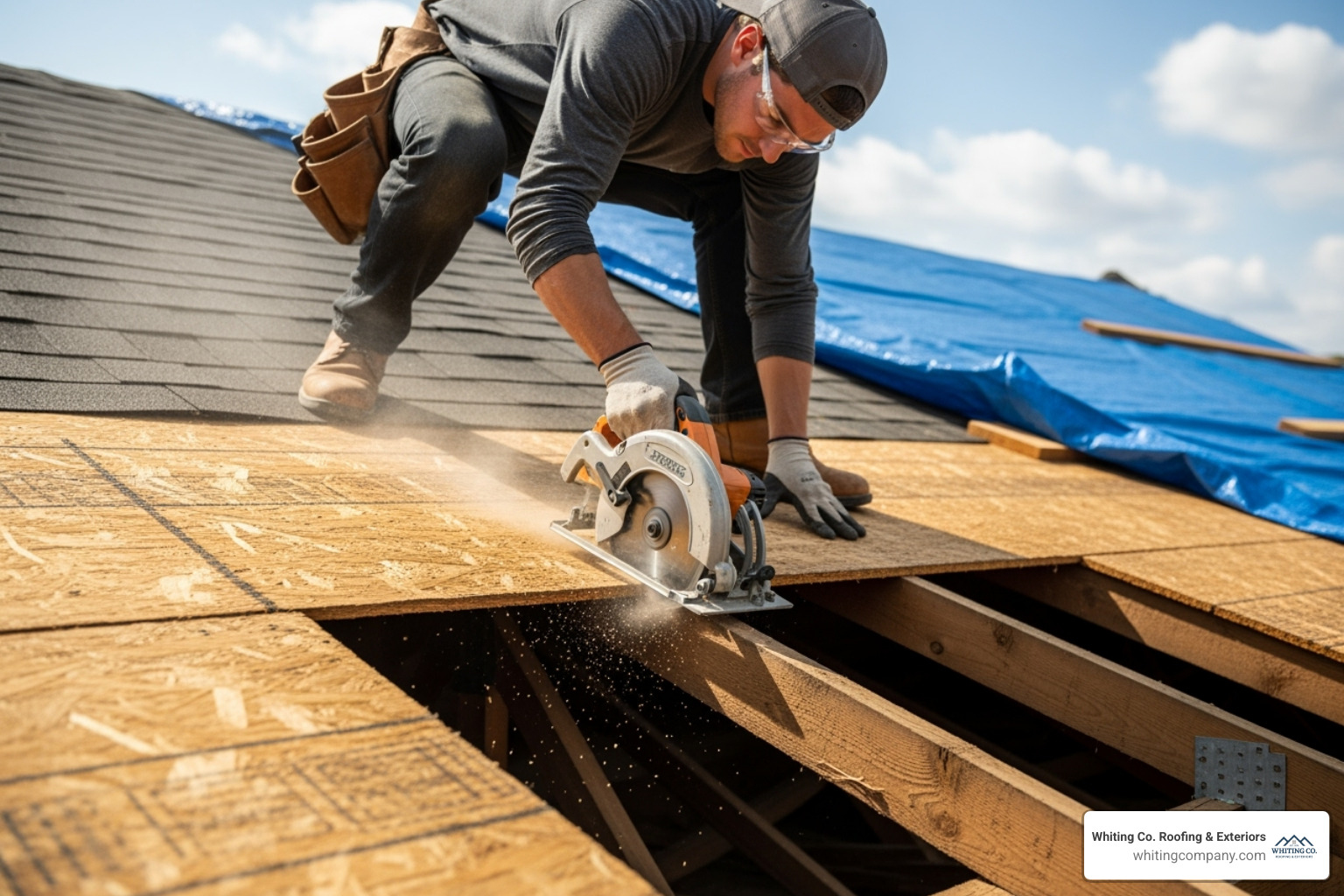
With the decking exposed, we conduct a thorough inspection of every square inch for rot, moisture damage, and structural weakness. All compromised sections are marked and carefully cut out. We also inspect the underlying rafters and trusses, reinforcing or replacing them as needed to ensure a stable support structure.
Step 3: Installing New Roof Decking
We install new sheathing, typically 7/16-inch OSB or 1/2-inch plywood, that meets or exceeds building standards. Our installation follows strict protocols for maximum strength:
- Staggered Seams: Sheets are staggered like bricks to prevent weak points.
- Proper Spacing: H-clips are installed between sheets to maintain a 1/8-inch gap, allowing for thermal expansion and preventing buckling.
- Precise Nailing: We follow a strict nailing pattern (e.g., every 6 inches on edges, 12 inches in the field) to ensure maximum uplift resistance, per NRCA guidelines and local codes.
The 2018 International Residential Code mandates solid sheathing for asphalt shingle installations, a standard we strictly adhere to for structural integrity.
Step 4: Completing the Roof System
With the new decking in place, we build the complete roofing system. This includes installing a new, high-quality synthetic underlayment and a self-adhering ice and water shield at vulnerable areas like eaves and valleys. We then install fresh flashing, drip edge, and your chosen roofing material according to manufacturer specifications. This systematic approach ensures every component works together for long-term durability. Learn more about our comprehensive roof installation services page.
Roof Decking Replacement Costs: What to Expect When Investing in Your Home’s Foundation
Investing in roof decking replacement is an investment in your home’s safety, durability, and value. The typical cost ranges from $5 to $8 per square foot, with most total projects falling between $2,500 and $10,000. A new roof, which includes decking, can deliver a 100% return on investment at resale, according to the National Association of Realtors’ 2022 Remodeling Impact Report.
Several factors influence the final cost:
- Roof Size and Complexity: Larger roofs or those with steep pitches, dormers, and valleys cost more.
- Extent of Damage: Replacing a few boards is much cheaper than a full deck replacement.
- Material Choice: Plywood is typically more expensive than OSB.
- Labor and Location: Labor rates vary by region; our Maryland-based pricing reflects local market conditions.
- Structural Repairs: Fixing damaged rafters or trusses will add to the cost but is critical for long-term stability.
Material Comparison: Plywood vs. OSB for Roof Decking – The Great Debate
Choosing between plywood and OSB involves balancing budget and performance. Both are excellent materials, but they have key differences.
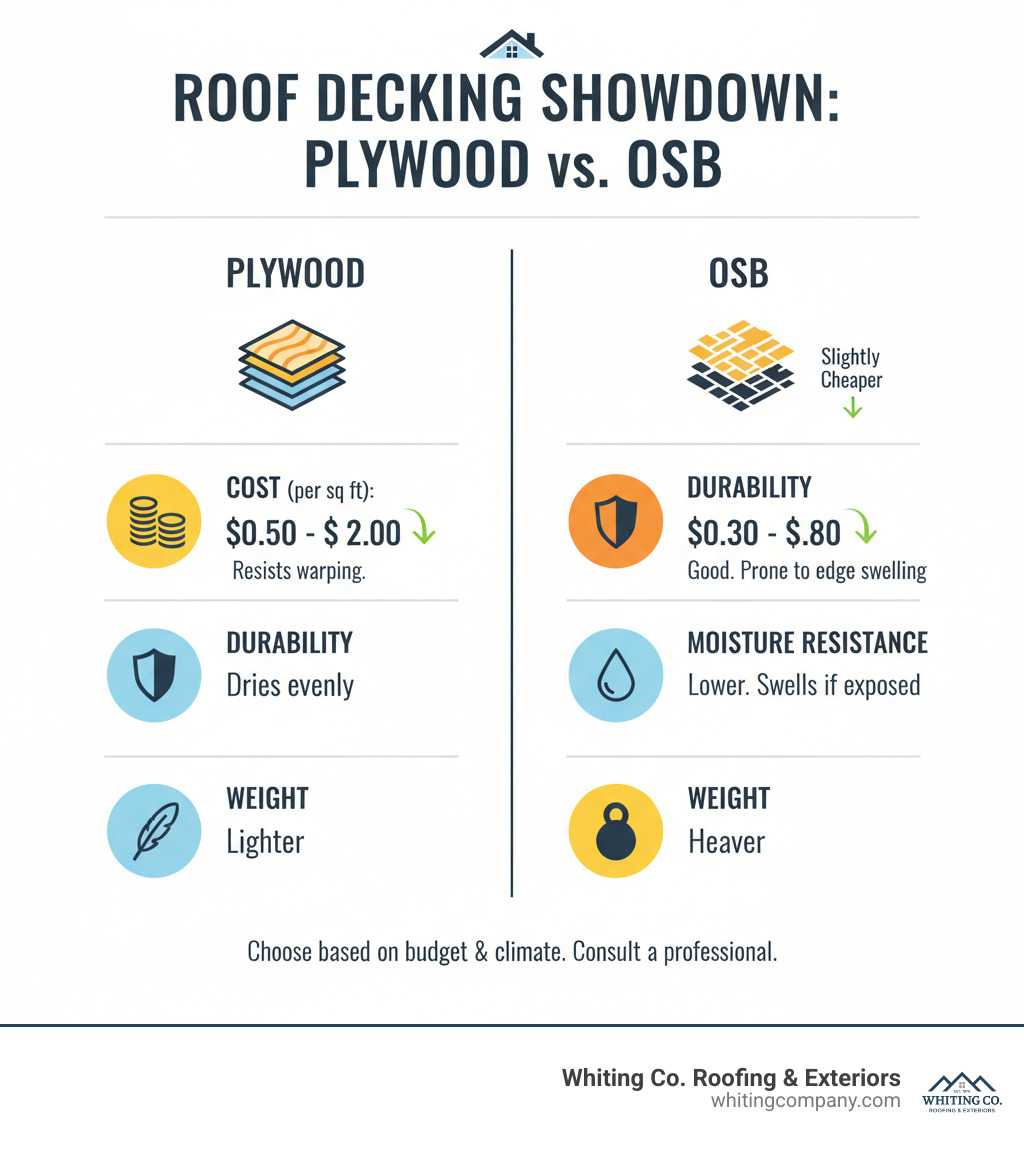
| Feature | Plywood | OSB (Oriented Strand Board) |
|---|---|---|
| Composition | Thin layers (veneers) of wood glued together | Wood strands/flakes compressed with adhesives |
| Cost (per sq ft) | $0.50 – $2.00 | $0.30 – $1.80 (slightly cheaper) |
| Cost (per sheet) | $30 – $40 | $25 – $35 |
| Durability | Stronger, more rigid, less prone to sagging | Strong, but can be more flexible than plywood |
| Moisture Resistance | Better resistance to swelling and delamination when wet; dries faster | More prone to swelling along edges if exposed to moisture for extended periods; absorbs water more readily |
| Weight | Generally lighter | Can be slightly heavier |
| Lifespan | 20-30 years | 15-25 years |
| Nail Holding | Excellent | Good |
| Common Thickness | 3/8″, 1/2″, 5/8″, 3/4″ | Typically 7/16″ |
Plywood is often considered the premium choice due to its superior strength and moisture tolerance. It resists swelling and dries faster, making it a durable option for Maryland’s humid climate.
OSB is the most common material in new construction, offering reliable structural performance at a more economical price. Its main vulnerability is moisture, as its edges can swell if exposed for prolonged periods.
Additional Costs to Consider – Beyond the Decking Itself
A complete roof decking replacement includes more than just the sheathing itself. Budget for these related expenses:
- Labor: Typically $1.75 to $3.25 per square foot, covering tear-off, installation, and system rebuilding.
- New Underlayment: Essential for secondary water protection ($0.50-$1.00/sq ft for synthetic felt).
- Disposal Fees: Dumpster rental and waste disposal can cost $200 to $500.
- Building Permits: Required by most municipalities, typically costing $50 to $250.
- Unexpected Repairs: It’s wise to budget an extra 10-20% for hidden issues like rotted rafters that are only finded during tear-off.
Preventing Future Roof Decking Damage: Proactive Strategies for a Healthier Roof
After investing in a roof decking replacement, protecting it is key to maximizing its lifespan. Most decking problems are preventable with proactive care.
The Unsung Hero: Proper Attic Ventilation
Poor attic ventilation can reduce a roof’s lifespan by up to 24 percent. A balanced ventilation system is your roof’s best defense against its two biggest enemies: moisture and heat.
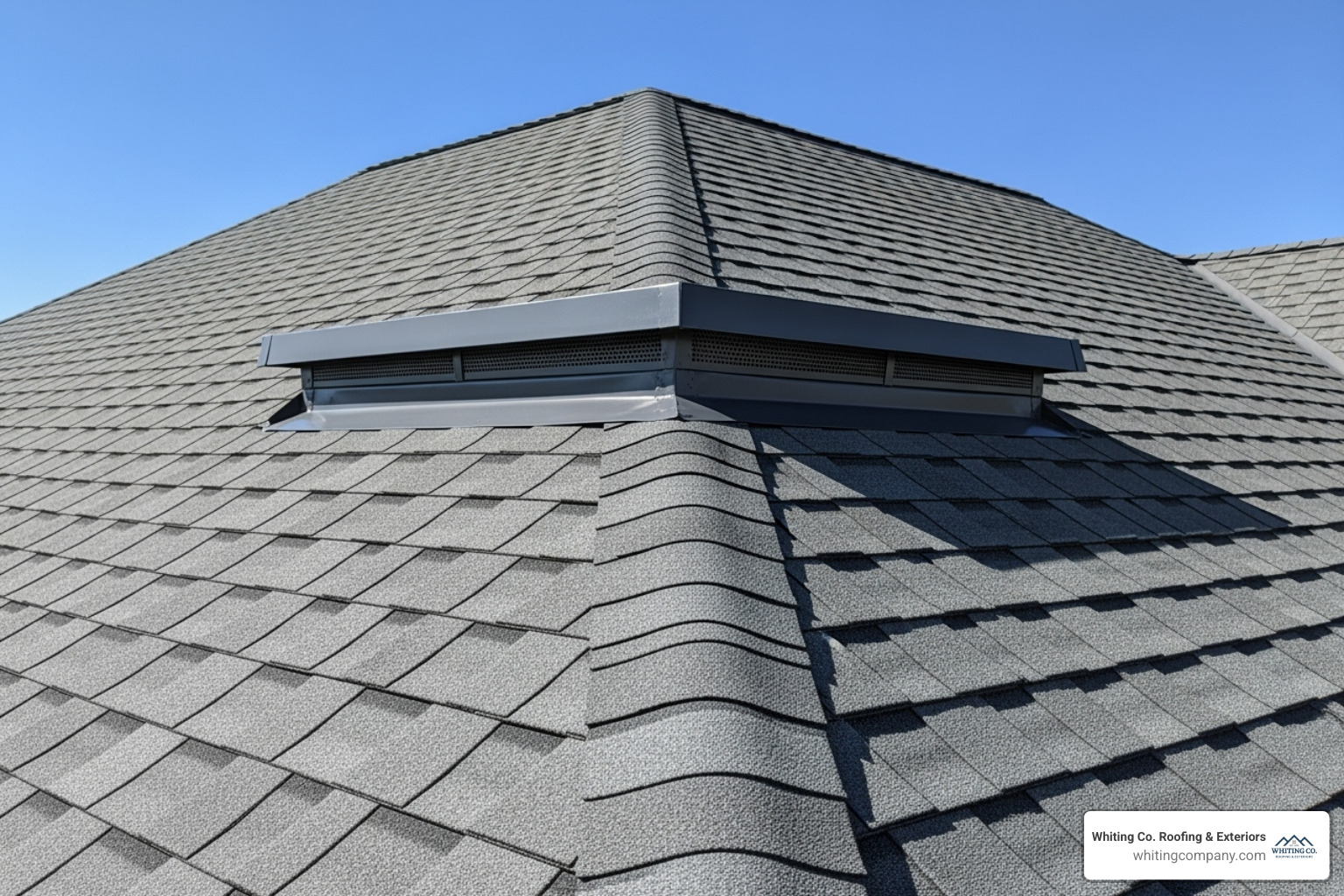
Proper ventilation allows cool, fresh air to enter through soffit vents and hot, moist air to exit through ridge vents. This constant airflow prevents moisture from condensing on the underside of your roof deck, which is a primary cause of mold and rot. It also regulates attic temperatures, preventing the extreme heat that can “bake” your shingles and decking from the inside out.
Address Leaks Immediately – Small Problems, Big Consequences
Even a small leak can cause significant decking damage over time. Water that reaches the sheathing begins a slow process of deterioration. By the time you see a stain on your ceiling, the damage is often already extensive. When you suspect a leak, act immediately. Professional roof repair services can fix minor issues before they escalate into a major roof decking replacement.
Schedule Routine Roof Inspections and Maintenance – Your Roof’s Annual Physical
Your roof needs regular check-ups. We recommend professional inspections at least once a year and after any severe weather event. During an inspection, a professional looks for:
- Damaged or missing shingles.
- Compromised flashing around chimneys, vents, and skylights.
- Clogged gutters that cause water to back up onto the roof edge.
- Overhanging tree limbs that can damage shingles and clog gutters.
Preventive maintenance catches small issues while they are still inexpensive to fix, saving you from costly repairs and extending the life of your entire roofing system.
Frequently Asked Questions About Roof Decking Replacement
Homeowners facing a roof decking replacement often have questions about the process, cost, and best practices. Here are answers to the most common inquiries we receive.
Can new roof decking be installed over old decking?
No, installing new decking over old is against industry best practices and most building codes. This practice, known as “sheathing over,” is risky for several reasons:
- It conceals problems like rot and mold, allowing them to worsen unseen.
- It adds excessive weight to your roof structure, which may not be engineered to support the extra load.
- It creates an uneven surface for new shingles, compromising their performance and appearance.
- It can void manufacturer warranties for your new roofing materials.
For a safe, durable, and code-compliant roof, all compromised decking must be removed and replaced.
How long does new roof decking last?
Properly installed plywood or OSB decking should last 20 to 30 years or more, often outlasting the shingles above it. Its actual lifespan depends on several factors:
- Material Quality: Higher-grade materials offer better durability.
- Attic Ventilation: Good ventilation is the single most important factor in preventing moisture and heat damage.
- Roofing System Integrity: Quality underlayment and shingles protect the decking from weather.
- Regular Maintenance: Promptly repairing leaks and performing annual inspections will maximize the decking’s life.
Does homeowners insurance cover roof decking replacement?
Insurance coverage for roof decking replacement depends on the cause of the damage. Policies typically cover damage from sudden, accidental events but not from gradual wear and tear.
- Covered Scenarios: Damage from “covered perils” like storms (wind, hail), fire, or fallen trees is usually covered.
- Non-Covered Scenarios: Damage resulting from lack of maintenance, such as slow leaks causing rot or general aging, is typically not covered.
Documenting the cause of damage is critical for a successful claim. If you suspect storm damage, contact our team for a professional evaluation and the detailed reports required by insurance companies.
Protect Your Home with Expert Roof Decking Replacement
Your home’s roof is its first line of defense, and the decking is its structural backbone. Installing a new roof over a compromised foundation is a recipe for failure. A roof decking replacement ensures the entire system is built on a solid, reliable base.
Ignoring warning signs like sagging, leaks, or soft spots can lead to structural instability, widespread water damage, and decreased property value. At Whiting Co. Roofing & Exteriors, we have served Maryland communities like Columbia, Odenton, and Annapolis for nearly 50 years, and we understand the unique challenges of our local climate.
Professional installation is essential for safety, code compliance, and protecting your investment. Our certified team provides meticulous roof decking replacement services, adhering to strict fastening patterns, material standards, and local building codes. This ensures your roof is built to withstand Maryland’s weather for decades to come.
Ready to secure your home with a solid foundation? Our comprehensive residential roofing services provide the long-term protection you deserve. Don’t wait for small problems to become costly emergencies—let’s build a roof that lasts.








